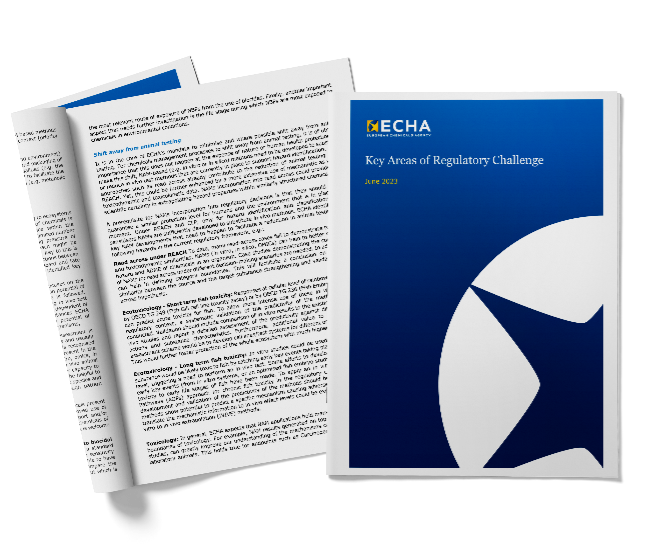
Dedicated research and the development of scientific methods are vital to attain the EU’s objectives for ensuring the safe use of chemicals and, ultimately, an animal-testing free chemicals regulation.
There is a lot of innovative and interesting scientific research ongoing, but regulators often need something supplementary or tailor-made to use the research results for legal frameworks. We need more dedicated research in the areas that will help protecting our health and environment with the regulations in place today. We also need dedicated research to develop the chemicals regulations of tomorrow.
Inform and inspire
To inform and inspire the research community we have identified scientific research needs and outlined them in the report “Key Areas of Regulatory Challenge”. This report not only lists topics for further research, but also highlights why these topics are of regulatory importance and how the new scientific knowledge is expected to be used in EU’s chemicals management, e.g. under the REACH, Classification, Packaging and Labelling (CLP), Biocidal Products (BPR) or the Persistent organic pollutants (POPs) regulations.
The list of key areas is not exhaustive but meant to inform and inspire the science community. They do not represent an official opinion of ECHA in light of ongoing regulatory procedures on the substances mentioned. Other areas, even if not listed, may also be relevant with research and development already ongoing. The key areas will be updated yearly.
With this report we are supporting the work under the EU-wide research and innovation programme ‘Partnership for the Assessment of Risks from Chemicals’ (PARC), which is co-funded by the European Commission and the EU countries. PARC funds scientific research and innovation and seeks to develop next-generation chemical risk assessment.
Areas needing more scientific research
Chemicals that can damage the immune or neurological system are spotlighted in the EU’s Chemicals Strategy for Sustainability (CSS). It also emphasises the importance of regulating chemicals that disrupt the endocrine system, both in humans and in environmental organisms. It is very challenging to detect these effects with the current methods that may have limitations or do not exist yet at all due to our limited understanding on how certain mechanisms of toxicity work in practice.
Test methods and understanding of the toxicological modes of action need to be developed further. We also need further insights how the outcomes of these methods can be used in risk management; how to identify hazards, facilitate safe use and take regulatory action where needed.
The Key Areas of Regulatory Challenge (KARC) provides suggestions on areas for further research or development. It also highlights concrete research topics that are detrimental to the challenges ECHA is facing. This concerns challenges we have today, but also those we see needed to achieve the regulatory ambition expressed in the CSS.
Further research would be needed for example in the following areas:
- Developing a better understanding on how the immune system develops in time from the foetus into adulthood and how chemicals interfere the development during critical windows of exposure.
- Developing of New Approach Methodologies (NAM) to assess possible neurotoxic effects for adults.
- NAM based on invertebrates for the identification of endocrine disrupting effects.
More information and research topics can be found in the chapter "Provide protection against most harmful chemicals"
The CSS identifies chemical pollution as one of the key drivers degrading ecosystems and reducing biodiversity.
The risks of chemicals to the environment are currently determined with information received from only a few representative organisms and a few ways of exposure. This approach is insufficiently protective since there may be other more sensitive organisms in the environment and the ways of exposure can be more complex. Additionally, environmental exposure is rarely to a single chemical but rather to a chemical cocktail.
Targeted NAMs can efficiently address the numerous interactions between chemicals and ecosystems and therefore, their development is needed to detect the impacts.
Further research would be beneficial for example in the following areas:
- developing non-vertebrate methods to assess the accumulation of chemicals in organisms and improving this assessment of air-breathing organisms,
- generating information on possible sensitivity of non-bee pollinators to biocidal active substances,
- monitoring of specific substances such as linear and cyclic siloxanes.
More information and research topics can be found in the chapter “Addressing Chemical pollution in the natural environment”
It is in the core of ECHA’s mandate to minimise and where possible shift away from animal testing. However, this shift cannot decrease the level of protection of our health and environment.
To make this shift, NAM-based (e.g. in vitro or in silico) methods need to be developed to replace, refine or reduce the need for in vivo test methods currently in place to identify hazards.
Further research would be needed for example in the following areas:
- Improving the detection of carcinogens including those acting through a non- genotoxic mode of action;
- validating a systematic in vitro/silico test-battery to steer generation of chronic toxicity data for vertebrate species.
More information and research topics can be found in the chapter “Shifting away from animal testing”